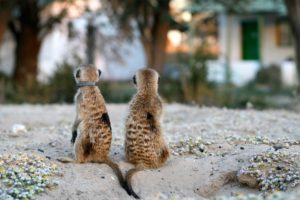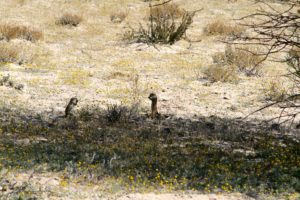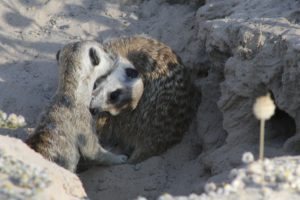
Mr. Holmes and Dr. Watson at Pandora engaging in some mutual grooming. These new boys at the group are getting much better around people, although they are still wary and seem to much prefer the comfort of each others’ company!
Welcome to my August 2016 field update, and let’s start with some good news. When I last wrote, I reported on the new males at Pandora. At the time, two new wild males had joined the group, neither were comfortable with us being around, and data collection had temporarily ceased at the group to allow for these individuals to settle in. I wrote that both I and the volunteers were spending time trying to habituate the new boys, and I was especially keen to catch the new dominant male, needing to vaccinate him against tuberculosis as part of my study. Well, my field season ended on 30 March, and in the last few days of the month two things went my way.
Firstly, I was able to officially christen the two new boys. For a number of weeks I had been following them both around in the field calling them Mr Holmes (dominant) and Dr Watson, and eventually these names stuck and were adopted by the rest of the team at the project. First success. I was very pleased with the progress that I had made with Mr Holmes, having been able to weigh him on several occasions and apply dye to his left flank to identify him. But would I be able to catch him? As it turned out I only had one opportunity before the end of the season. I promised Laura, one of the current project managers, that he was indeed habituated enough to catch, and then, with my reputation riding upon it, managed to take my one and only chance!
Just as with Guinness, 15 months before, the process of habituating an individual, seeing the improvement over time, and gradual increase of trust, was an amazing experience for me. Whatever beneficial science, and other experiences I will take away from this project, the one on one interactions with individual animals, that all of the volunteers here have every day, will be a very personal highlight. I am happy to say that Mr Holmes appeared to forgive me, and is now vaccinated and a well habituated member of Pandora. Dr Watson has come on a long way, but remains a work in progress.
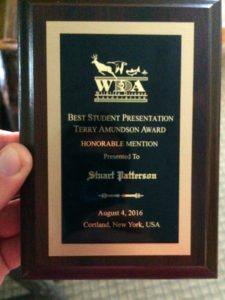
The meerkat tuberculosis research received this award in August 2016 following a presentation at the Wildlife Disease Association conference.
One of the principal responsibilities of a researcher, I believe, is not only to carry out the research, but also to disseminate it. After 2 ½ years of study on this project, I am now at a stage to begin producing outputs. Two scientific papers which I have authored are currently in the review stage for publication in journals (I’ll let you know when I have news), and this year I had a presentation accepted at the Wildlife Disease Association (WDA), which I gave at the start of this month. The WDA is the international body of researchers and practitioners concerned with wildlife health. This year their conference was attended by nearly 400 delegates, and so it was an excellent opportunity to raise the issue of tuberculosis in the meerkats on the world stage. My presentation was co-authored by my supervisors, Tim Clutton-Brock, Julian Drewe and Dirk Pfeiffer, and was entitled “Who’s at risk: heterogeneities in the risk of tuberculosis in wild meerkats”. I am pleased to tell you that this work was awarded the Terry Amundson honourable mention award for a student oral presentation . The week-long meeting was an excellent opportunity to meet a great bunch of like-minded researchers, all working to improve wildlife health internationally, and our work on meerkats raised a lot of interest, sparking many useful discussions. I must take a moment to thank the Royal Veterinary College’s Animal Care Trust and student travel award, as well as the WDA’s own student travel award, as without these grants, I would not have been able to travel to North America for this conference.
I returned to the Kalahari in the second week of August for what is due to be my final field season out here. As you will no doubt have read in the life history reports, the meerkat population here has thus far failed to recover from last year’s drought. Many of the current groups are very small, but I hope that as long as we can keep hold of these individuals, they will form the seeds of a population expansion over the next 12 months.
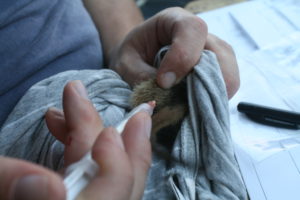
Part of the ongoing tuberculosis study involves vaccinating pups in certain groups. This happens at their first routine sampling session and involves a single injection into the back leg. Here I’m carrying out an injection at a group in August. The pups all tolerate this very well.
Tuberculosis cases appeared to be notably lower than expected during the months of drought, making a reappearance as conditions have improved. At the current time, I believe that this may be because when experiencing tough environmental conditions, infected animals were dying sooner, and so disappearing before they developed the clinical signs that we are used to seeing. I am currently developing the evidence to support this theory but it would suggest that the disease has an underlying effect that we do not see, in addition to the losses from full disease that we are used to.
The recent cases of disease that we have seen at the project were in Uberkatz, Pandora, Baobab, and Ewoks. This unfortunately has brought about the very rapid decline and ultimately extinction of Uberkatz, the second group that we have lost this year after Drie. Clearly TB remains a major concern here, continuing to bring about the local extinction of our groups. Currently we have no knowledge of how widespread this disease is and whether it is only meerkats affected. We only have evidence from our own study population.
I currently have both a study group of squirrels, and a habituated meerkat group, the newly named Thunderkatz, living outside of my room at the project, so I have plenty of inspiration as I begin to write up my work. Keeping track of individuals and new groups is a task in its own right, and I currently have a large diagram on my desk outlining where animals that I have been studying over the last two years have moved during that time. It was good to see Kazeh and Ash this morning when we sampled animals at Ewoks, even though they were members of Jaxx when I began this project. Jaxx alone currently have members in Thunderkatz (Poletje and Chewbacca named by the Friends are now here), Ewoks, and Quintessentials (where Paddington is now dominant) as well as the main group. All of that gets a little confusing. The social perturbation caused by the drought seems to be responsible for the recent high degrees of mixing.
- Thunderkatz pair Poletje and Sarah-Anne with the project buildings behind. This group is currently babysitting so close to the accommodation that they are seen every night. Excellent motivation for work.
- Poletje and Sarah-Anne accompanied by the first pup to emerge at new group, Thunderkatz. I went over to their burrow this evening to see them and was delighted at the first appearance of this pup. Who knows whether more remain below waiting to emerge.
- These squirrels from the Klein Oukies group share the same burrow as Thunderkatz and are part of the study population for the cape ground squirrel project on site. Again, regularly spotted by the researchers!
I’m looking forward to the remainder of this season. The current group of volunteers and managers at the project are all working very hard to keep track of the groups that we have, and working with them over the coming weeks looks like it will be another positive experience. The support that I get on the ground from the managers Chris and Laura, and until last week Helen, is critically important to the work that I am trying to do. I will continue to sample the population until the end of September, and maintain vaccinations in study groups, after which time I will head south to Stellenbosch to process these samples in the laboratory there. After a few days with my colleagues there, I will return to the UK to complete the analysis of our results and draw conclusions from the project, which I of course will be keeping you up-to-date with. I’ll be in touch to let you know how the final weeks of sampling have gone. Many thanks as always for your support.



